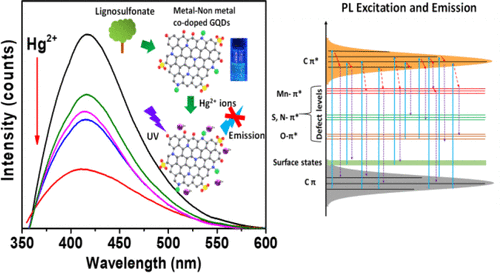当前位置:
X-MOL 学术
›
ACS Sustain. Chem. Eng.
›
论文详情
Our official English website, www.x-mol.net, welcomes your
feedback! (Note: you will need to create a separate account there.)
In Situ Doping-Enabled Metal and Nonmetal Codoping in Graphene Quantum Dots: Synthesis and Application for Contaminant Sensing
ACS Sustainable Chemistry & Engineering ( IF 7.1 ) Pub Date : 2020-10-28 , DOI: 10.1021/acssuschemeng.0c05789 Aruna N. Nair 1 , Venkata S.N. Chava 1 , Saptasree Bose 1 , Ting Zheng 2, 3 , Srikanth Pilla 2, 3, 4, 5 , Sreeprasad T. Sreenivasan 1
ACS Sustainable Chemistry & Engineering ( IF 7.1 ) Pub Date : 2020-10-28 , DOI: 10.1021/acssuschemeng.0c05789 Aruna N. Nair 1 , Venkata S.N. Chava 1 , Saptasree Bose 1 , Ting Zheng 2, 3 , Srikanth Pilla 2, 3, 4, 5 , Sreeprasad T. Sreenivasan 1
Affiliation

|
Fluorescent graphene quantum dots (GQDs) prepared from low-cost and sustainable precursors are highly desirable for various applications, including luminescence-based sensing, optoelectronics, and bioimaging. Among different natural precursors, the unique structural and compositional variety and the abundance of aromatic carbon in lignin make it a unique and renewable precursor for the green synthesis of advanced carbon-based materials including GQDs. However, the inferior photoluminescence quantum yield of GQDs prepared from natural precursors, including lignin, limits their practical utility. Here, for the first time, we demonstrate that the presence of heteroatoms in the innate structure of lignosulfonate can be leveraged to derive in situ heteroatom-doped GQDs with excellent photophysical properties. The as-synthesized lignosulfonate-derived GQDs showed compelling blue fluorescence with a high quantum yield of 23%, which is attributed to in situ S and N doping as confirmed by using X-ray photoelectron spectroscopy and Fourier transform infrared spectroscopy analyses. Assisted by the in situ doping, we further engineered the lignosulfonate-derived GQDs by incorporating a metal atom dopant to derive an enhanced quantum yield of 31%, the highest for any lignin-derived GQDs. Moreover, fundamental photoluminescence studies reveal the presence of multiple emissive centers, with edge states acting as dominant emission centers. Finally, we also demonstrate the applicability of the luminescent, metal- and nonmetal-codoped lignin-derived GQDs as a highly selective sensor for the sub-nanomolar level detection of mercuric ions in water.
中文翻译:

石墨烯量子点中的原位掺杂使能金属和非金属共掺杂:污染物感测的合成和应用
由低成本且可持续的前体制备的荧光石墨烯量子点(GQD)对于包括基于发光的传感,光电和生物成像在内的各种应用都是非常理想的。在不同的自然前体中,木质素中独特的结构和成分以及丰富的芳香族碳使其成为绿色合成高级碳基材料(包括GQD)的独特且可再生的前体。但是,由天然前体(包括木质素)制备的GQD的光致发光量子产率较低,限制了它们的实际应用。在这里,我们首次证明了木质素磺酸盐固有结构中杂原子的存在可以用来衍生具有优异光物理性质的原位杂原子掺杂的GQD。合成的木质素磺酸盐衍生的GQD表现出引人注目的蓝色荧光,量子产率高达23%,这归因于原位S和N掺杂,这通过X射线光电子能谱和傅里叶变换红外光谱分析得以证实。在原位掺杂的辅助下,我们通过掺入金属原子掺杂剂进一步设计了木质素磺酸盐衍生的GQD,以提高31%的量子产率,这是所有木质素衍生GQD的最高。此外,基本的光致发光研究揭示了多个发射中心的存在,边缘状态充当了主要的发射中心。最后,我们还证明了发光,金属和非金属掺杂的木质素衍生的GQD作为高选择性传感器可用于亚纳摩尔水平的水中汞离子检测。
更新日期:2020-11-09
中文翻译:

石墨烯量子点中的原位掺杂使能金属和非金属共掺杂:污染物感测的合成和应用
由低成本且可持续的前体制备的荧光石墨烯量子点(GQD)对于包括基于发光的传感,光电和生物成像在内的各种应用都是非常理想的。在不同的自然前体中,木质素中独特的结构和成分以及丰富的芳香族碳使其成为绿色合成高级碳基材料(包括GQD)的独特且可再生的前体。但是,由天然前体(包括木质素)制备的GQD的光致发光量子产率较低,限制了它们的实际应用。在这里,我们首次证明了木质素磺酸盐固有结构中杂原子的存在可以用来衍生具有优异光物理性质的原位杂原子掺杂的GQD。合成的木质素磺酸盐衍生的GQD表现出引人注目的蓝色荧光,量子产率高达23%,这归因于原位S和N掺杂,这通过X射线光电子能谱和傅里叶变换红外光谱分析得以证实。在原位掺杂的辅助下,我们通过掺入金属原子掺杂剂进一步设计了木质素磺酸盐衍生的GQD,以提高31%的量子产率,这是所有木质素衍生GQD的最高。此外,基本的光致发光研究揭示了多个发射中心的存在,边缘状态充当了主要的发射中心。最后,我们还证明了发光,金属和非金属掺杂的木质素衍生的GQD作为高选择性传感器可用于亚纳摩尔水平的水中汞离子检测。











































 京公网安备 11010802027423号
京公网安备 11010802027423号